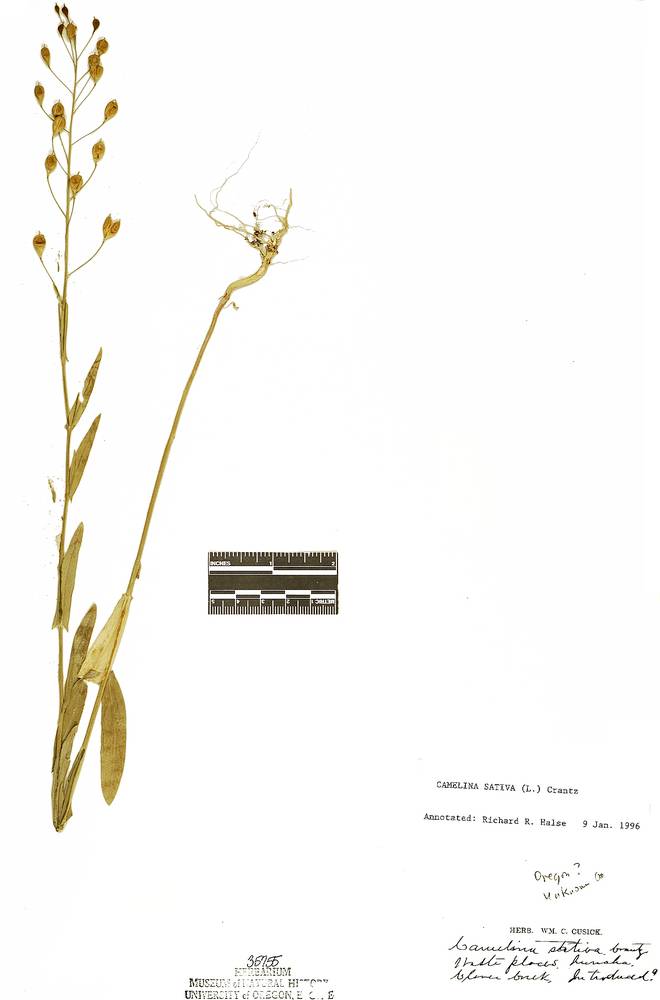
Plants annual or biennial.
Stems (1.2)3–10(13) dm, basally glabrous or with minute branched trichomes.
Basal leaves often withered at anthesis.
Cauline leaves lanceolate, narrowly oblong, or linear-lanceolate, middle (1)2–7(9) cm × 2–10(15) mm, bases sagittate or strongly auriculate, margins entire or rarely remotely denticulate, surfaces glabrate or sparsely pubescent with primarily forked trichomes.
Inflorescences fruiting pedicels ascending, (8)12–20(27) mm.
Flowers sepals 2–3(4) mm; petals oblanceolate, (3.5)4–6 × 1–1.5 mm, yellow; styles 1.2–2.5 mm.
Fruits pyriform or broadly obovoid, 7–9(13) × 4–5(6) mm, often subtruncate at apex; valves prominently veined, narrowly winged at margin.
Seeds oblong, (1.5)1.8–2.5 × 0.7–1 mm, dark brown.
2n=40.
Grassy areas, fields, waste places. Flowering May–Jun. 100–1000 m. BW, WV. ID, WA; scattered worldwide. Exotic.
as described under Camelina sativa
Annuals or biennials. Stems unbranched or branched distally, (1.2-)3-10(-13) dm, glabrous or sparsely pubescent basally, trichomes branched, rarely mixed with fewer, simple ones. Basal leaves often withered by anthesis. Cauline leaves: blade lanceolate, narrowly oblong, or linear-lanceolate, (1-)2-7(-9) cm × 2-10(-15) mm, base sagittate or strongly auriculate, margins entire or, rarely, remotely denticulate, apex acute, surfaces glabrescent or sparsely pubescent, trichomes usually forked. Fruiting pedicels ascending, (8-)12-20(-27) mm. Flowers: sepals 2-3(-4) × 0.5-1 mm; petals yellow, (3.5-)4-6 × 1-1.5 mm; filaments 1.5-3 mm; anthers ca. 0.5 mm. Fruits pyriform or broadly obovoid, 7-9 (-13) × 4-5(-6) mm (distinctly longer than wide), apex often subtruncate; valves each with prominent midvein, margin narrowly winged; style 1.2-2.5 mm. Seeds dark brown, (1.5-)1.8-2.5 × 0.7-1 mm. 2n = 40.Flowering May-Jun. Farms, grassy areas, fields, waste places; 0-1500 m; introduced; Alta., B.C., Man., N.W.T., Nunavut, Ont., Que., Yukon; Colo., Conn., D.C., Ill., Ind., Iowa, Kans., Maine, Mass., Mich., Minn., Mo., Mont., Nebr., N.H., N.J., N.Mex., N.Y., N.Dak., Ohio, Oreg., Pa., S.C., S.Dak., Vt., Va., W.Va., Wyo.; Europe; Asia; introduced also in South America, Australia.R. L. McGregor (1985) indicated that Camelina sativa is no longer established in North America; we tend to agree because we have not seen any collections made within the past 40 years.